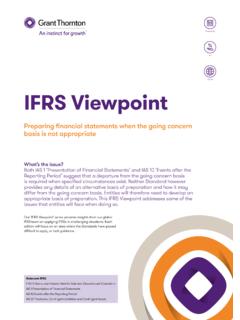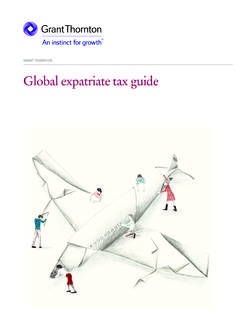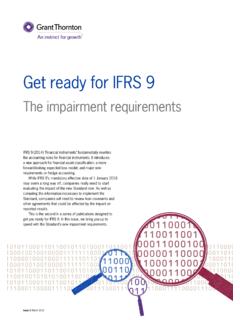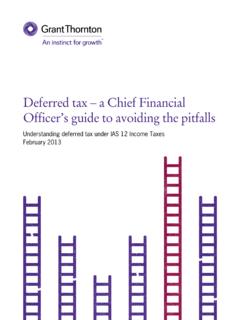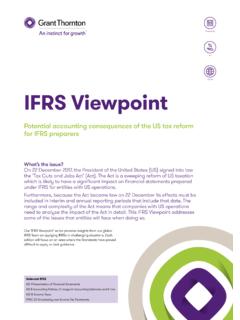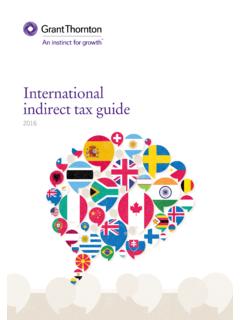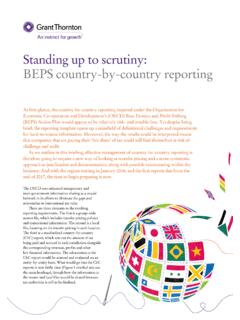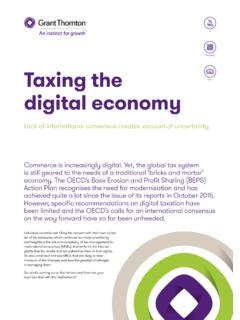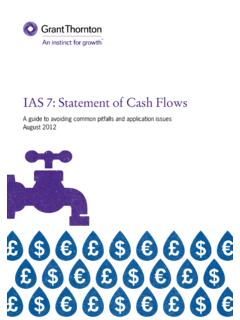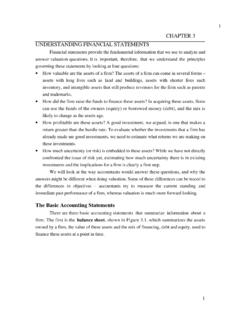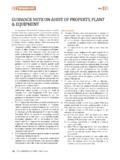Transcription of Intangible Assets in a Business Combination
1 Intangible Assets in a Business combinationIdentifying and valuing intangibles under IFRS 3 November 2013 Important Disclaimer:This document has been developed as an information resource. It is intended as a guide only and the application of its contents to specific situations will depend on the particular circumstances involved. While every care has been taken in its presentation, personnel who use this document to assist in evaluating compliance with International Financial Reporting Standards should have sufficient training and experience to do so. No person should act specifically on the basis of the material contained herein without considering and taking professional advice. Grant Thornton refers to the brand under which the Grant Thornton member firms provide assurance, tax and advisory services to their clients and/or refers to one or more member firms, as the context requires. Grant Thornton International Ltd (GTIL) and the member firms are not a worldwide partnership.
2 GTIL and each member firm is a separate legal entity. Services are delivered by the member firms. GTIL does not provide services to clients. GTIL and its member firms are not agents of, and do not obligate, one another and are not liable for one another s acts or omissions. Neither GTIL, nor any of its personnel nor any of its member firms or their partners or employees, accept any responsibility for any errors this document might contain, whether caused by negligence or otherwise, or any loss, howsoever caused, incurred by any person as a result of utilising or otherwise placing any reliance upon it. Identifying and valuing intangibles under IFRS 3 2013 iThe last several years have seen an increased focus by companies on mergers and acquisitions as a means of stabilising their operations and increasing stakeholder value by achieving strategic expansion and cost reduction through Business combinations. Although such transactions can have significant benefits for an acquiring company, the related accounting is complex.
3 IFRS 3 Business Combinations (IFRS 3) requires an extensive analysis to be performed in order to accurately detect, recognise and measure at fair value the tangible and Intangible Assets and liabilities acquired in a Business Combination . Furthermore, the interaction of IFRS 3 with IFRS 10 Consolidated Financial Statements (issued May 2011) and IFRS 13 Fair Value Measurement (issued May 2011) means that this continues to be both a complex and a developing area of financial accounting for Intangible Assets acquired in a Business Combination is particularly challenging for a number of reasons. Intangible Assets are by nature less detectable than tangible ones. Many are not recognised in the acquiree s pre- Combination financial statements. Determining their fair value usually involves estimation techniques as quoted prices are rarely an Intangible resource is not recognised as an Intangible asset , it is subsumed into goodwill. Some acquirers might be motivated to report fewer intangibles , and higher goodwill, because most Intangible Assets must be amortised whereas goodwill is measured under an impairment only approach.
4 However, a high goodwill figure can create the impression that the acquirer overpaid for the acquired Business . It also raises questions as to whether IFRS 3 has been applied correctly. Acquirers can expect reported amounts of Intangible Assets and goodwill to be closely scrutinised by investors, analysts and for Intangible Assets in a Business Combination is therefore a sensitive area of financial reporting. Fortunately, Grant Thornton one of the world s leading organisations of independent assurance, tax and advisory firms with more than 35,000 Grant Thornton people across over 100 countries has extensive experience with Business combinations and the related accounting requirements. Grant Thornton International Ltd (GTIL), through its IFRS team, develops general guidance that supports the Grant Thornton member firms (member firms) commitment to high quality, consistent application of IFRS. We are pleased to share these insights by publishing Intangible Assets in a Business Combination (the Guide).
5 The Guide reflects the collective efforts of GTIL s IFRS team and the member firms IFRS experts and valuation specialists. Introductionii Identifying and valuing intangibles under IFRS 3 2013 The Guide includes practical guidance on the detection of Intangible Assets in a Business Combination and also discusses the most common methods used in practice to estimate their fair value. It provides examples of Intangible Assets commonly found in Business combinations and explains how they might be valued. An overview of IFRS 3 summarising the main aspects of accounting for Business combinations as a whole that draws out a number of practical points to consider may also be found in GTIL s guide: Navigating the accounting for Business combinations: applying IFRS 3 in practice (December 2011).This Guide is organised as follows: Section A explains the general procedures necessary to detect Intangible Assets in a Business Combination . It outlines some of the strategies that are commonly used to detect acquired technologies, trademarks, and other resources that may meet the definition of identifiable Intangible Assets in a Business Combination Section B explains fundamentals of fair value measurement as well as common methods to estimate the fair value of Intangible Assets .
6 Key inputs for each method are identified and various examples further illustrate the issue Section C explains the characteristics of Intangible Assets that are frequently found in practice and common methods used to estimate their fair value. Factors that will usually impact their fair value measurement are also discussed. Case Thornton International LtdNovember 2013 The Guide includes practical guidance on the detection of Intangible Assets in a Business Combination and also discusses the most common methods used in practice to estimate their fair value. Introduction iA. Detecting Intangible Assets 11 General requirements 1 Definition of an Intangible asset 1 Identifiability 22. Strategies to detect identifiable Intangible Assets 4 Business model review 4 Other important sources 5 Determining which identifiable Intangible Assets require measurement 63. Common identifiable Intangible Assets 9B. Measuring Intangible Assets 111.
7 General approaches to fair value 11 Which approach to use? 12 Cornerstones of fair value measurement in Business combinations 132. Market approach methods 18 Key inputs 18 Sales transactions comparison method 18 Methods using market multiples 193. Cost approach methods 19 Key inputs 19 Reproduction cost method 20 Replacement cost method 234. Income approach methods 24 Key inputs 24 Relief-from-royalty method 30 Comparative income differential method (CIDM) 32 Multi-period earnings excess method (MEEM) 34 ContentsC. Common Intangible Assets in Business combinations 411. Marketing-related Intangible Assets 41 Trademarks, service marks and related items 41 Internet domain names and websites 42 Non-compete agreements 422. Customer-related Intangible Assets 43 Customer lists or similar databases 43 Customer contracts: open orders and production backlogs 44 Customer relationships 453. Technology-related Intangible Assets 47 Third-party software licenses 47 Technology (other than third-party software) 474.
8 Other contract-related Intangible Assets 48 Reacquired rights 49 Operating lease contracts; licensing arrangements; other user rights, including supplier agreements 495. Assembled workforce 50 Case Study Service Provider 511. Trade name 512. Service provider number 523. Customer relationships 534. Non-compete agreements 565. Summary of Intangible Assets fair values 59 Identifying and valuing intangibles under IFRS 3 2013: Section A 1 A. Detecting Intangible Assets Recognition and fair value measurement of all of the acquiree s identifiable Assets and liabilities at the acquisition date are amongst the key elements of the acquisition method required by IFRS 3. The method implies that all Assets and liabilities are known to the acquirer. In practice however, detecting or finding identifiable Intangible Assets in particular may be a complex matter which requires intensive research into the acquired Business . How does the acquirer determine which Intangible Assets need to be recognised separately from goodwill?
9 This Section provides insights into how to go about doing this. The general requirements for identifiability and the definition of an Intangible asset are explained. The Section also discusses how identifiable Intangible Assets are detected in practice, complemented by a list of Intangible Assets that should be considered in Business General requirementsEconomically, many Intangible resources , value drivers or advantages are essential parts of a Business . However, in accounting for Business combinations these have to be analysed from two different perspectives in order to determine what should be recognised separately from goodwill: the resource must meet the definition of an Intangible asset and it must be identifiable as part of what is exchanged in the Business Combination (rather than in a separate transaction or arrangement). Definition of an Intangible assetThe acquirer must first assess which resources meet the definition of an asset in accordance with The Conceptual Framework for Financial Reporting (the Conceptual Framework) at the acquisition date.
10 The Conceptual Framework defines an asset as follows:Definition of an asset (Conceptual Framework paragraph (a)) An asset is a resource controlled by the entity as a result of past events and from which future economic benefits are expected to flow to the addition, an Intangible asset other than goodwill is defined as an identifiable non-monetary asset without physical substance (IFRS A). The first step to detect Intangible Assets in a Business Combination is to find future economic benefits that are controlled by the entity at the date of acquisition as a result of the Business Combination . Potential Intangible Assets could take the form of additional income (or cost savings) and should therefore be capable of directly or indirectly increasing future cash the relevant identifiable Assets is not affected by specific exemptions in IFRS 3 or other standards. For example, it does not matter whether or not an Intangible asset was recognised in the acquiree s financial statements prior to the Combination (IFRS ).

